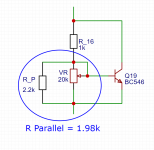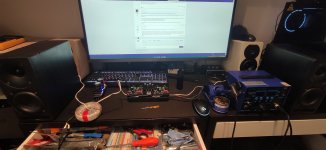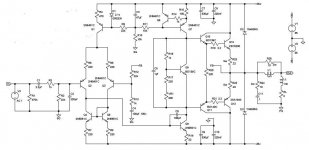Yes i have tons of them!Do you have any 2N5551 lying around? Same pinout, higher voltage.
Attachments
Might be OK for a commercial product (check © with Rod Elliott first).What about making an integrated board?
But as a DIYer I prefer to keep modules separated so I can swap them around without rebuilding the whole thing every time.
Did you get first sound yet?
Didn't tested it yet, I don't have any 2k Multiturn Pot 🙁Might be OK for a commercial product (check © with Rod Elliott first).
But as a DIYer I prefer to keep modules separated so I can swap them around without rebuilding the whole thing every time.
Did you get first sound yet?
I've been wondering if a 20k would do the job as well...
You might try to put a fixed resistor in parallel.Didn't tested it yet, I don't have any 2k Multiturn Pot 🙁
I've been wondering if a 20k would do the job as well...
Look here.
Yes that would do the trick!You might try to put a fixed resistor in parallel.
Look here.
Attachments
Tested this morning, but there is something wrong, Left Channel perfect, Right Channel puts out +VS on the speaker output... nothing is wrong about the PCB and all the parts are correct... Idk what's going on...Might be OK for a commercial product (check © with Rod Elliott first).
But as a DIYer I prefer to keep modules separated so I can swap them around without rebuilding the whole thing every time.
Did you get first sound yet?
Bias is set to minimum, all voltages are correct...
Last edited:
Well the point, with my P3 project from ESP site, I just used it for my HNC project, and expanded upon the design a little (parallel pairs as per the site description).Integrated board is nice, but I too would probably use a small PCB for the output transistors and associated bits-thats just me
Since my work designing my first, and pretty rudimentary PCB, etched one sided only, wasn't commercial nor required to be original by the examiner, unlike a Degree, I had no qualms copying the design and fiddling with it a tiny bit.
So I etched the PCB, built the chassis and tested the amplifier, and got distinction.
I would speak to ESP first as other have suggested, as I don't think a commercial version is wise, without a conversation with the designer.
You likely now have a problem with the R channel output transistors. Have you measured and at least compared the expected R and L channel Vce, Vbe of the output and driver transistors? Take care making these powered measurements between the small lead/pin spacings when you only have standard (i.e. slippery) type meter probes. One slip or a dropped probe and phttt!...... bye-bye to your expensive semis. Try to use hook probes or at least sharp, hard point probes to reduce the risk of shorts. This isn't just advice to beginners - it's also a note to myselfTested this morning, but there is something wrong, Left Channel perfect, Right Channel puts out +VS on the speaker output...
 .
.Solved, Q5 BD139 faulty (STm from Digikey).You likely now have a problem with the R channel output transistors. Have you measured and at least compared the expected R and L channel Vce, Vbe of the output and driver transistors? Take care making these powered measurements between the small lead/pin spacings when you only have standard (i.e. slippery) type meter probes. One slip or a dropped probe and phttt!...... bye-bye to your expensive semis. Try to use hook probes or at least sharp, hard point probes to reduce the risk of shorts. This isn't just advice to beginners - it's also a note to myself.
Up and running ✌️
Attachments
After 1 hour listening, I can say it's really good, one thing is missing though... bass!
Used a 3.3uF C1 input cap instead of 4.7uF but I don't think that's the problem.
Used a 3.3uF C1 input cap instead of 4.7uF but I don't think that's the problem.
How good at reproducing bass, are the speakers (the black boxes, I guess?) that you are using for the test - assuming you do have a reference amplifier that doesn't have any form of bass boost either, for the purpose of fair comparison.
@Ian Finch @jacques antoine those little black boxes are terrific at bass response, they can easily reach 40Hz... Reference amp:
Attachments
Do you have any 2N5551 lying around? Same pinout, higher voltage.
Not exactly same pinout.
EBC vs CBE. Easy to make mistake when soldering them.
I'd like to see the relevant datasheets for CBE 2N5551 type in a TO92 package. Every basic type I searched from Motorola/Fairchild/Onsemi to NXP and others, comes up EBC. Note the transistor outline/pinout sketches may not be generated by the same graphic projection method (i.e. 1st angle V 3rd angle method) so the leads could appear to be in the same arrangement when they are not.
- Home
- Amplifiers
- Solid State
- ESP P3A



